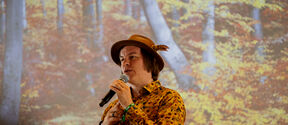Anything but an ordinary greenhouse
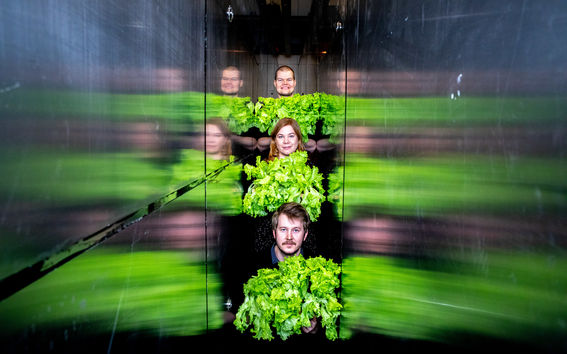
The engineering workshop is cramped. A seven-metre sheet of birch plywood fills the entire floor of the facility, which is located on Puumiehenkuja, Otaniemi.
A pair of carpenters squats beside the sheet holding screw guns, which they use to attach thinner wooden sheets dotted with oval holes into the large plywood sheet.
The air smells of a mixture of wood and glue.
Project manager Pasi Herranen stands by the door, observing the carpenters’ work. The plywood sheet will become a roofing element of a greenhouse he has named Plant Factory.
His greenhouse will be anything but traditional.
Plants are typically grown in humidity-resistant glass sheds, but this greenhouse will be made almost entirely out of wood. Plants will be grown on several layered decks without daylight.
Compared to a traditional glass greenhouse, Herranen’s design conserves energy, water, soil and nutrients. The new invention consumes 50% less energy when used for year-round cultivation in conditions resembling Finland. The invention is suited for use both in Finland’s freezing conditions and under the scorching Sahara sun.
All water is recycled in full. Only the water content of harvested plants leaves the greenhouse, Pasi Herranen says.
Sustainable plant production is crying out for innovations like this windowless wood-structured greenhouse. Herranen’s invention could find demand in construction more broadly.
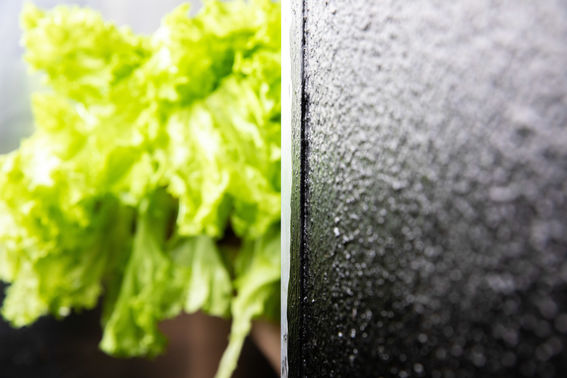
Self-confidence boosted by poker success
Two wall modules stand finished in the workshop. The rough black rubber mass on the edges is there to keep the walls airtight.
The massive modules aren’t easy to move, and four metal rings have been mounted on both sides of the wall for attaching crane chains. Important technology has been concealed
underneath plywood sheets, where sensors will monitor the dampness of the wood.
Technology has fascinated Pasi Herranen since a young age. His matriculation examination grades had already earned him a place at Tampere University of Technology, but a childhood friend convinced him to apply to Helsinki University of Technology while he was performing his national military service.
Herranen chose to major in strength of materials with production technology as a minor subject. Both are fields that he finds useful in his present job as a project manager.
As a student, he lived in a seven-person shared apartment, where the flatmates passed time by drinking coffee and throwing darts, in addition to which the played online poker.
‘A student pal was doing well in the game, so I decided to give it a go as well,’ Herranen says.
Online poker was a popular hobby at the beginning of the new millennium, and some players even managed to make a living at it. Herranen also started playing professionally and his studies were sidelined for some ten years. He played online and travelled to casinos around the world, winning and losing money.
His calm disposition provided a good starting point for the game, and expertise in maths and statistics helped him win.
‘I was able to maintain my calm when losing, I didn’t let it disturb my focus on the game.’
Success in poker enhanced his faith in his own decision-making abilities. Herranen says the confidence derived from poker is precisely why he was able to trust his calculations and believe in his invention.
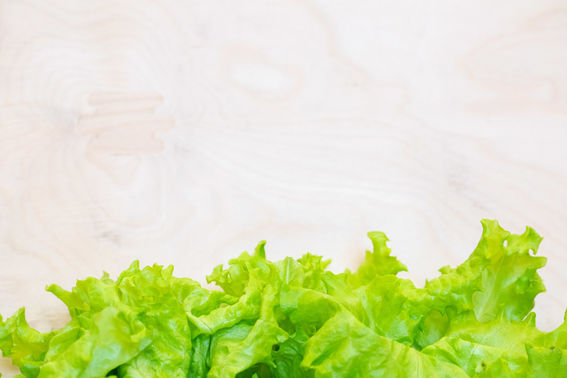
Wood bested metal
Herranen had three alternative subjects for his Master’s thesis. Two of them related to metal, which he was familiar with because of his mechanical engineering studies. But the properties of plywood represented something new and intriguing.
For his thesis, Herranen performed tensile tests in the materials strength testing hall at Otaniemi during which he’d stretch plywood until it snapped. In addition, he computer modelled the stress endurance of different shaped plywood pieces. The unique properties of wood won him over.
‘Wood is a strong and durable material that doesn’t conduct much heat. It is renewable, affordable and workable. It is also readily available.’
After graduating, Herranen kept thinking about a wooden wall module built utilising vacuum drying, a method that removes water through evaporation in a vacuum.
Wood has been vacuum dried for more than a century, but Herranen’s idea of applying the technique to the drying of an entire wall module was new. The technique is also what the project’s official name, Vacuum Insulation System (VIS), was derived from.
Vacuum drying directs intense pressure on plywood panels, which is why Herranen designed a specific wooden interior structure to go between the panels and help maintain the integrity of the wall module in spite of the high pressure.
But a theoretical model alone would not suffice, proof of the idea’s viability was needed as well.
Two weeks became twelve months
During the first years, Pasi Herranen worked without pay and all alone, with only strong faith in his own calculations to lean on. At times, the bills would stack so high that he was forced back to the poker table to grind out some cash.
Building the prototype by hand also strained his patience. He had imagined that the prototype would be completed in a couple of weeks, but this estimate was far off the mark. The Otaniemi materials strength testing hall witnessed many frustrating moments of trial and error.
‘The hardest part was developing the right coating to keep the module air-tight.’
Finally, Herranen could showcase a prototype that, according to VTT Technical Research Centre of Finland, insulated heat sufficiently.
Instead of two weeks, the making of the prototype had consumed a year.
His original plan was for the wall modules to be used in the construction of houses and office buildings, but after reading a Natural Resources Institute Finland LUKE report on growing cucumbers, he realised his wooden modules were a perfect fit for greenhouse applications.
‘The commercialisation possibilities were better for greenhouses.’
Pasi HerranenThe confidence derived from poker is precisely why I was able to trust my calculations and believe in my invention.
Growing in stacked layers
Traditional glass-structured greenhouses lose lots of energy. They need to be heated a lot particularly in winter, as their poor insulation allows heat to escape. Growing cucumbers, for example, requires greenhouses to be kept at a temperature of +27 degrees Celsius.
And the problems continue in summertime, when glass greenhouses get too hot. Opening roof hatches helps, but this also lets out carbon dioxide, which plants need to grow. This is why cucumber harvests are two times bigger in winter than they are in summer.
Pasi Herranen compared glass greenhouse harvest numbers to the computer simulations of his own invention.
‘My numbers looked good straight away,’ he recalls.
Replacing natural light with efficient LED lamps further improved the numbers.
‘The problem with sunlight is that there’s either too much or too little of it,’ Herranen continues.
LED lamps would enable growers to regulate the amount and wavelength of light, which would make the plants grow quicker than usual.
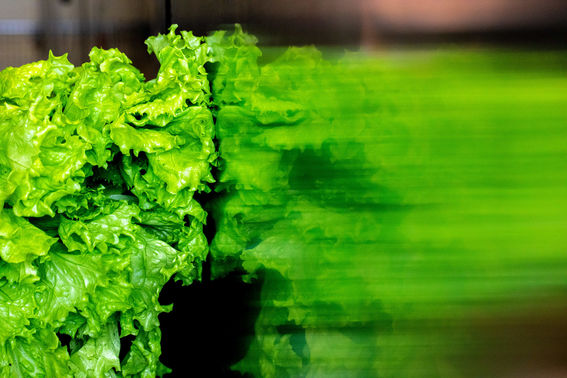
The windowless structure of the greenhouse is beneficial in other ways too. For example, light pollution, which disturbs nature and humans, is not an issue. Instead, light is exploited with maximal efficiency inside the greenhouse. The silvery aluminium that coats the modules reflects the LED light onto the growing plants.
On top of all this, the LEDs save energy. When plants are grown in stacked layers, there is no need for a heat source other than the LED lamps.
‘In a well-insulated Plant Factory, the energy of the LEDs is transformed into thermal energy via the plants. This is enough to keep the space warm even during the harshest winter freeze. There’s even enough excess heat to be distributed to others through the district heating grid.’
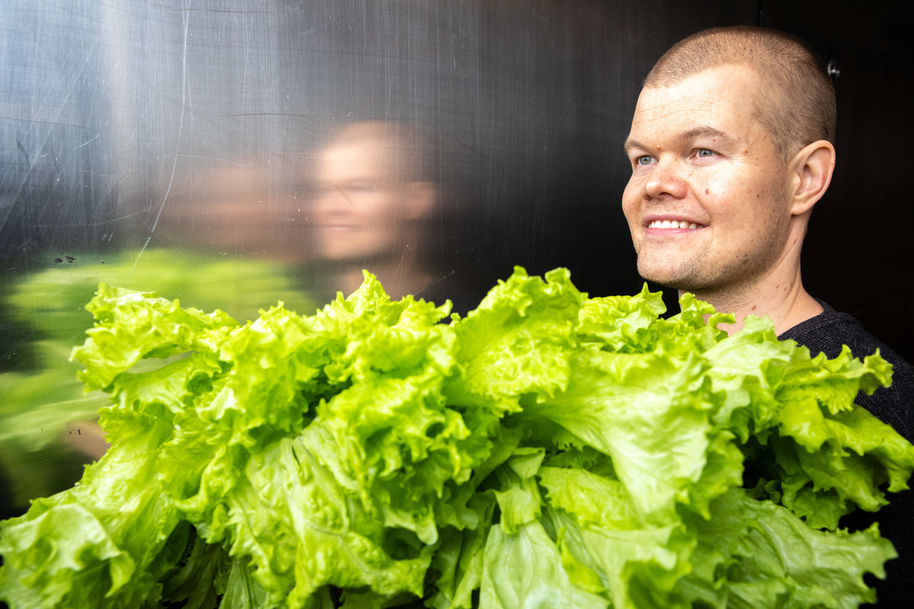
New type of greenhouse for Otaniemi
The carpenters at the workshop have almost finished the interior frame of the first roof module and stacks of birch plywood panels for the roof modules to be assembled next lean against the wall awaiting their turn.
Herranen directs the Aalto University Magazine photographer. The wooden interior lattice must not be visible in any of the pictures, as the patent application is still being processed.
The other members of the project team stand between two metal-sheen wall modules to pose with Herranen. Economics graduates Panu Miettinen and Orvokki Ihalainen brought necessary commercialisation expertise to the project.
The trio say that, in future, their modules could be found suitable for the building of homes and offices as well. The invention is estimated to have a potential market worth billions.
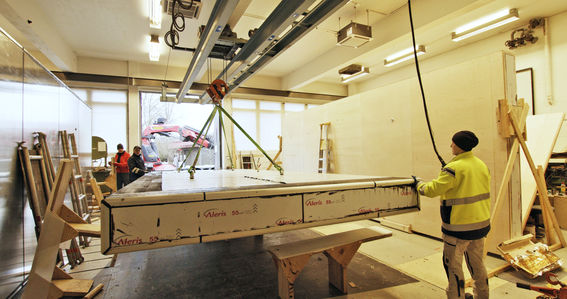
The modules built at the workshop will be taken to the LUKE research centre in Piikkiö, where a 65-square-metre greenhouse will be erected and its flat roof fitted with solar panels.
The first heads of lettuce will be growing in Herranen’s greenhouse by next summer.
The planned next step is to build a Plant Factory greenhouse in Otaniemi. In addition to growing lettuce, the intention is to trial heat production. Excess heat will be transferred from the greenhouse into a new heating grid being built in Otaniemi.
Ideally, the growing of lettuce would bind more greenhouse gases than cultivation generates, Herranen says.
‘This would enable the carbon-negative cultivation of vegetables in future.’
This article is published in the Aalto University Magazine issue 26, April 2020.
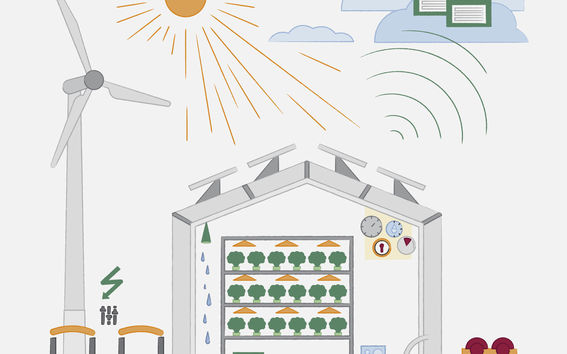
In future, greenhouses built from Vacuum Insulation System (VIS) modules will produce food, energy and heat.
- Plants grow in stacked layers, enabling land-use efficiencies up to a hundred times greater than in outdoor farming. Vertical farming conserves arable land and makes it unnecessary to fell forests to make room for food production.
- LED lamps generate an ideal spectrum of light for photosynthesis. This enhances the nutrient intake of plants and improves their taste.
- Airtight shell prevents evaporation, cutting water consumption by 99% compared to traditional farming.
- The greenhouse itself functions as a long-term carbon storage.
- The water that evaporates from plants is recovered and reused.
- Vacuum pump can be attached to VIS modules at any time.
- Vacuum drying makes the VIS elements dry and healthy, thanks to which the walls’ life cycle is very long. Humidity removal from finished wall modules necessary once a year according to estimates.
- Greenhouse roof covered with solar panels.
- LED lights can be switched off during electricity price peaks, reducing average power cost per area under cultivation.
- Extensive set of sensors that send real-time data to the cloud on heat, humidity, carbon dioxide content and wind speed.
- Efficiency optimised with the aid of AI.
- Excess heat can be fed into a district heating grid.
- Produces about 2 megawatts per 1 000 square metres.
Titta Kotilainen, Senior Scientist, Natural Resources Institute FinlandSustainable plant production calls for solutions of exactly this kind.
Comments on the invention
‘I first heard about Pasi’s idea when we were sat around a campfire at a summer cottage in Punkaharju seven years ago. The invention sounded good even then. We later went over the numbers together and realised that a windowless greenhouse had strong commercial potential. People are more and more interested in food’s carbon footprint. The rapid development of LED technology has also been a boon for us.’
‘The most memorable part of the project was hearing we’d be getting TUTLI finding. This was a significant moment. Being granted funding meant that our idea was considered viable, and we’d be able to take big leaps forward in developing the invention.’
‘This is it! That’s what I thought when I first heard about the idea at a Finnish Glasshouse Growers’ Association event. The greenhouses we import from Holland are not energy-efficient in Finland’s climate, they are too poorly insulated. And any old warehouse is not suitable for vertical farming, even though this is often suggested. Sustainable plant production calls for solutions of exactly this kind. Especially when LED lamps can handle both the lighting and the heating.’
‘At first, I thought it peculiar for this innovation to not exploit free natural light. Improving energy-efficiency is a good thing, as heating a glass greenhouse consumes a lot of power, especially in winter. I very keen for growing to start and results to come in.’
‘When we start planning the commercialisation of an invention, two things in particular are considered. First of all, the invention needs to be a significant improvement over existing solutions. Secondly, the team itself must have a willingness to go commercial. It has been a joy to observe this project, in which both conditions are met so well.’
‘Greenhouses are just one example of what these modules can be used to build. Mould problems seem to afflict buildings no matter what material they are made from. The popularity of wood construction continues to increase and these modules will remain completely dry.’
‘The project has proceeded unfalteringly. From initial idea to construction of the prototype, and from measuring the prototype to building an actual greenhouse. The team’s competencies complement each other. They have succeeded in presenting a vision of this invention’s many potential applications.’
Aalto does well in TUTLI funding applications
The commercialisation of the greenhouse invention was made possible by Business Finland’s New Business from Research Ideas (TUTLI) funding. The Vacuum Insulation System project was granted this funding at the beginning of 2019.
TUTLI funding amounting to €41 million was extended to 81 Aalto-associated projects in 2012–19. More than half (52%) of applicants have received funding. The funding scheme was renamed Research to Business at the beginning of 2020.
Among others, the following Aalto-rooted companies have received TUTLI funding over the years: Iceye, Surgify, Yieldsystems, Fractuscan, XFold Imaging, Elfys, Koite Health, Ladimo, Addcomposites, Agilefant, Unified Charges.
Watch the video to see how the massive module is carried out from the workshop.
Read more news
Apply to be a guest professor or visiting researcher at the Université Grenoble Alpes
Unite! partner, Université Grenoble Alpes (UGA) has opened a call to host international professors and researchers for short stays.
Postdoctoral researcher Eloi Moliner makes history as a 5-time award winner
Eloi Moliner is one of the most decorated doctoral researchers in Aalto University's history – we would like to highlight his success and contributions to the field of audio signal processing
2 million euro donation to Aalto University's new multidisciplinary Bachelor’s programme – Donors: Matti Alahuhta, Sari Baldauf, Antti Herlin, and Jorma Ollila
Set to launch in autumn 2027, the multidisciplinary Bachelor's programme combines technology, business, arts, and design